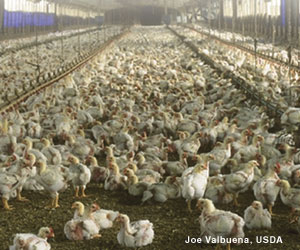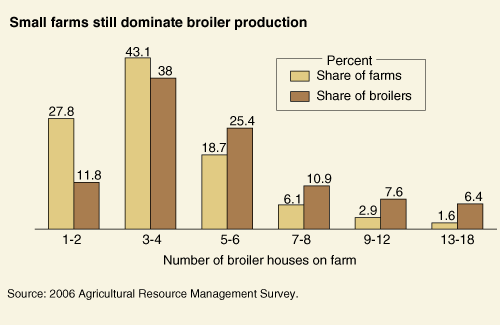Small Farms Still Important in Broiler Production
James
M. MacDonald 
Agricultural production is shifting to large farms:
in 2006, farms with at least $500,000 in sales
accounted for over 60 percent of U.S. agricultural
commodity sales. But broiler production—raising
young chickens for meat—remains an exception.
While U.S. broiler operations are getting larger,
small farms still dominate production.
Unlike other commodities, the important role played
by small broiler operations suggests that no significant
and systematic cost advantages accrue to farm size.
Moreover, smaller operations limit the potential
spread of poultry diseases as well as the concentration
of poultry manure.
Commercial growers almost always produce broilers
under a production contract with an integrator.
Most integrators are corporations that own processing
plants, feed mills, and hatchery farms. An integrator
provides the grower with chicks, feed, and veterinary
services and transports the birds to processing
plants. The grower invests in broiler houses (a
significant capital investment), provides labor
and purchases utilities, and feeds the chicks until
they reach market weight (5-9 weeks).
Seventy percent of all contract growers own four
or fewer broiler houses, and those operations collectively
accounted for half of the 8.9 billion broilers
produced in the U.S. in 2006. Each house produces
between 110,000 and 120,000 broilers annually,
and, on average, growers are paid 26-27 cents per
bird. As a result, the smallest operations—those
with a single house—realize about $32,000
in annual contract fees for broiler production,
while operations with four houses realize about
$126,000.

Broilers provide one source of income to households
that run small grow-out farms. Most operations
produce other farm commodities (primarily cattle
and field crops), although broiler fees account
for nearly 90 percent of total commodity revenue.
Grower households also receive income from farm-related
activities, including rentals of farmland and custom
work for other farms, such as harvesting or planting
services. In addition, grower households receive
income from off-farm work and from other sources.
Income diversification is important for growers:
most face a choice of only one or two integrators
close enough for contracting. The availability
of other earning options for growers, whether from
other farming activities or off-farm employment,
tends to limit integrators’ market power.
On average, operators of small broiler grow-out
operations received a household income of $63,700
in 2006, of which about 30 percent represented
net income received from their farming business.
This is slightly below the average for all U.S
households ($66,570) but compares quite favorably
to mean household incomes in rural areas in the
South ($44,804), where broiler production is concentrated.
|